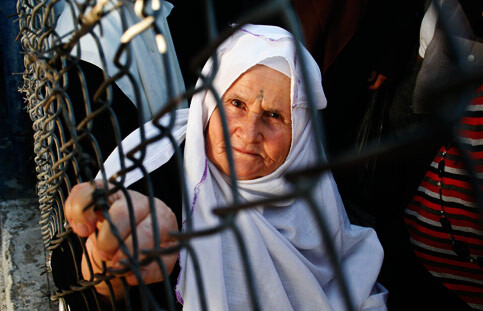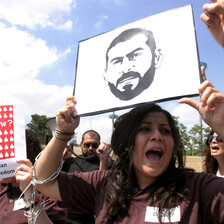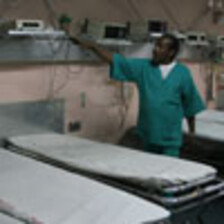Gaza Strip 3 December 2008

Along with their basic material needs not being met, many of Gaza’s 1.5 million people are suffering from psychological diseases due to the Israeli siege. (Hatem Omar/MaanImages)
Israel’s siege on Gaza, now in its 19th month, has wreaked havoc on all aspects of life and significant attention has been paid in particular to the economic consequences of border closures and blockade. However, an overlooked epidemic threatens the social and familial ties that bond the 1.5 million Palestinians in Gaza. Living under a constant state of crisis in which their livelihoods have been denied, the people of Gaza’s once exemplary resilience and determination are giving way to an unfathomable sea of depression and psychological illnesses.
According to the Palestinian Central Bureau of Statistics, as a direct result of Israel’s siege, 65 percent of households in Gaza struggle to obtain basic needs such as food, clothing and medicine. Among those struggling is Fouzan Salah, a 35-year-old father of four. Fouzan, who owned a tailoring factory with his brother, began selling his sewing machines in January of this year in order to feed his family. Since Israel began restricting the entry of goods and raw material into Gaza, an estimated 55 percent of private sector establishments have shut down and 97 percent of industrial establishments ceased their operations. Such was the fate of Fouzan’s factory, which received all of its fabric from Israel. The family now has no income and is in danger of losing its home. They Salahs currently rely on charity and the assistance of others, surviving on one, sometimes two small meals a day.
Consequently, Fouzan suffers from severe depression. Despair, worthlessness, incapacitation and emasculation is how Fouzan described the feelings he carries within him each day to the next. “I wasn’t worried when the siege first began,” he said. “I was just like everyone else and it was absurd to think that Israel would continue to enforce the siege on an entire population. It was unimaginable to even conceive that they would take away the livelihoods of all of us civilians. But I was wrong, we were all wrong. And now I’m still like everyone else, living a nightmare. It didn’t take me that long to reach this realization, and that’s when the depression hit me hard.”
Though Israeli officials assert that the closure of Gaza is meant to deter the firing of rockets towards Israel, the blockade better understood as a means of collective punishment intended to turn the population of Gaza against the Hamas-run government. This tactic has implications that will have a further, longer-lasting reach than the direct impact on Gaza’s economy and infrastructure.
“My husband’s condition causes him to be angry and enraged almost all of the time,” explains Ghada, Fouzan’s wife. “We walk on eggshells. He has tried to look for a job but there are no jobs available. Factories have let their workers go, businesses have shut down, the market is empty. We pray for an end, any end. How do you think it feels to be a grown man with a family and feel like an invalid, to not have a single coin in your pocket, to watch your children go hungry and barefoot and claim that you are responsible for protecting them? The younger children are becoming aggressive, insecure and less attentive to their schoolwork. Randa, my oldest daughter, is showing signs of deep depression.”
Most children in Gaza have experienced trauma, and the siege has had a multifold effect on top of that. According to the Gaza Community Mental Health Programme (GCMHP), 15 percent of Palestinian schoolchildren in Gaza are intellectually impaired due to malnutrition. Families like Fouzan’s cannot afford vegetables and meat; their diet consists of lentils, pasta, bread, rice and potatoes, high-carbohydrate foods deficient in other necessary nutrients. Children are also psychologically affected by the siege’s impact on their families. GCMHP statistics show that 47 percent of Palestinian children in Gaza suffer from psychological shock without their parents, who are unable to cope with the situation, even realizing it.
At 15, Randa is tall, slender, beautiful and charmingly shy. She was all smiles as she awaited my questions in privacy, proud to be considered important enough to have something to say. When the subjects of her father’s depression, her mother’s agonizing worry and the poverty they had been reduced to were broached, Randa’s lower lip quivered and she brushed the issues aside with a few giggles and a lowering of her eyes. When asked her about her friends, her face lit up. “I love my friends so much,” she said.
Tears welled up in Randa’s eyes and in a hesitating voice she added, “I love waking up in the morning just to leave the house. My father screams like a madman if we make the slightest noise. I’m not mad at him, I know that my grandmother makes him angry when she asks for money he doesn’t have when she needs to buy medication, and I know that he and my mother are always sad because they can’t buy us things we need, like food.” A sob escapes, but she can no longer hold it in. “I’m sad all the time but I can’t talk to my mother, because she cries all day long, and it would only make her cry harder. I don’t tell my friends everything, but I love my friends, they love me too, we have fun together.” She forces a smile and dries her face with a tissue.
It is one thing to the evaluate numerically-calculated losses resulting from Israel’s siege on Gaza, but what about the wider, more long-term effects that will be endured by Randa’s generation? The impact of isolating Gaza’s population from the rest of the world will be felt long after the physical blockade is lifted. The mental effects of post-traumatic stress disorder and depression among children are proven to persist into adulthood. Unless Israel’s siege ends immediately and is followed by intensive emergency aid programs, the future does not look bright for the children of Gaza.
Safa Joudeh is an master’s candidate in public policy at Stony Brook University in the US. She returned to Gaza in September 2007 where she currently works as a freelance journalist.
Related Links





